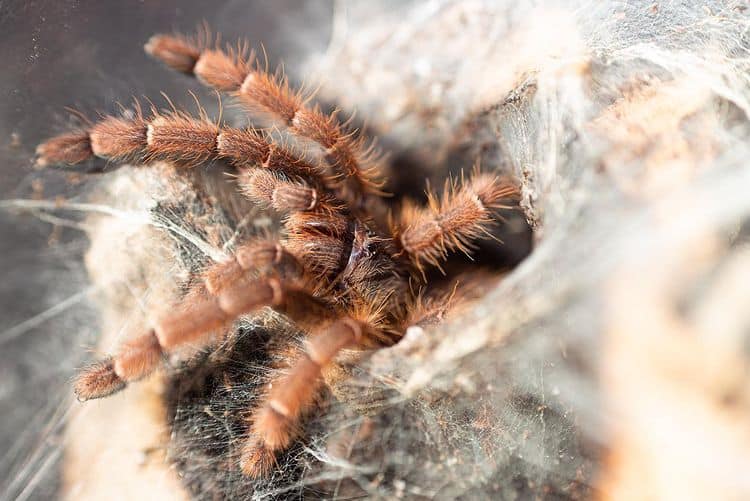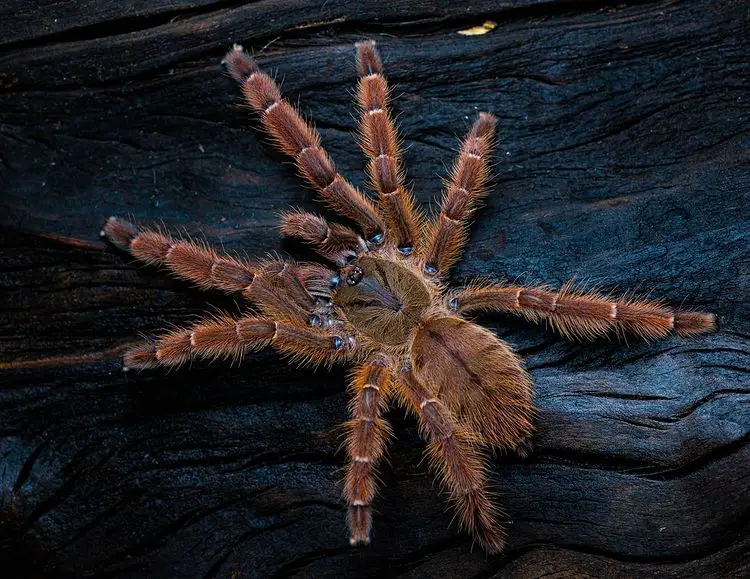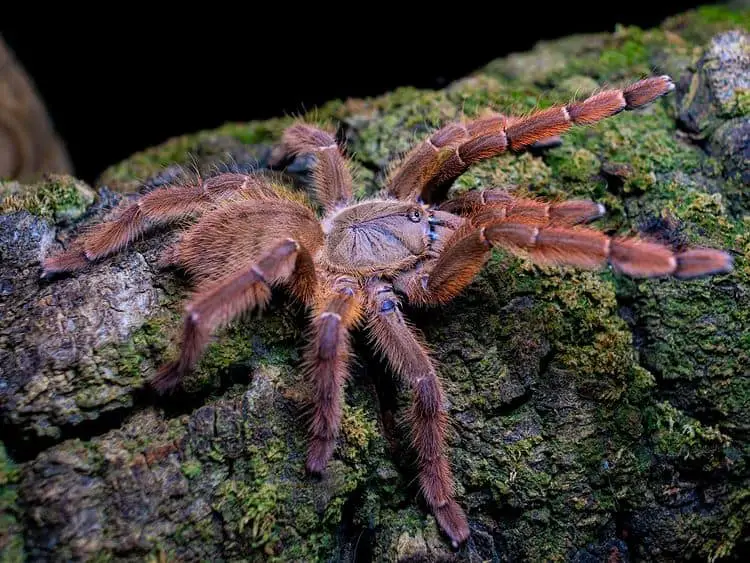The Peach Earth Tiger Tarantula (Phormingochilus sp rufus) is an Old World Arboreal tarantula that comes from Asia. They are known for their bursts of speed and defensive demeanor when they are cornered.
Due to their interesting appearance, the Peach Earth Tiger Tarantula has grown in popularity as an exotic pet.
If you’re considering adding this wonderful specimen to your collection, here’s everything you need to know about them!

Peach Earth Tiger Tarantula Care Sheet
| Name of Species | Phormingochilus sp rufus |
| Family | Theraphosidae |
| Common names | Peach Earth Tiger Tarantula |
| Native location | Indonesia |
| Category | Old World |
| Type | Arboreal |
| Leg span | 6 inches |
| Growth speed | Fast |
| Urticating hairs | No |
| Diet | Insects, primarily roaches & crickets |
| Social | Solitary |
| Temperature | 72 – 82°F (22 – 28°C) |
| Humidity | 70 to 80% |
| Life span | Females: 10 to 12 years / Males: 2 to 3 years |
| Experience level | Experienced |
Peach Earth Tiger Tarantula Overview
The Peach Earth Tiger Tarantula lives in the trees on the island of Java, which is part of Indonesia. This makes it an Old World Arboreal species.
It’s known scientifically as the Phormingochilus sp. rufus and is known for its extremely fast speed as well as its defensive nature, which does not make it a very suitable spider for first-timers.
Appearance

The Peach Earth Tiger Tarantula might be fast and defensive, they’re also extremely beautiful. They have a striking display of colors. Their legs are a beautiful orange, almost fawn color, a color that continues through the carapace and abdomen. They also have interesting tiger stripes on the abdomen, which give them an interesting contrast.
They’re not the largest spider. Females typically top out at a size of about 6 inches, while males are usually a bit smaller than that.
Price
If you’re interested in purchasing a Peach Earth Tiger Tarantula for your collection you should be aware that they’re quite an expensive species. The price does depend on whether you’re purchasing a male or female, as well as the age of the specimen you buy.
Typically, unsexed 0.5-inch slings can be found for a pretty cheap price of around $20. However, for a 3″ female the price already goes up to around $200, and for a sub-adult female, you can expect to pay around $700.
Temperament and Behavior
The Peach Earth Tiger Tarantula is fast and defensive. If necessary it will defend itself from threats that are bigger than itself. Whereas most tarantula species have a tendency to run from threats, this specimen is not afraid to stand its ground and use its powerful venom to defend itself.
They do tend to display a warning by putting up a threat posture before biting, but they will bite if you do not back off.
Also, since it’s very fast, it’s best to be careful when interacting with this spider. If you’re unknowingly agitating them they can use a burst of speed to bite you before you even know it.
Furthermore, due to their defensive nature and potent venom, you shouldn’t handle this tarantula.
They’re also quite decent webbers and can make some interesting constructions.
Caring for the Peach Earth Tiger Tarantula

Despite the fact that its potent venom, high speed, and defensive demeanor make it unsuitable for beginners, the Peach Earth Tiger Tarantula is not particularly hard to care for. As long as you provide them with an enclosure that has a good substrate, the right climate, good food, and the right size, they’ll be able to thrive in captivity.
Here’s exactly what you need to provide your Phormingochilus sp rufus with!
Tank setup
The Peach Earth Tiger is an arboreal species. As such, they need an enclosure that prioritizes height over width and length because they need space to climb.
As a rule of thumb, make sure that the enclosure is at least 4 times as tall as the spider’s length, and that the length of the enclosure is about 2 to 3 times as big as the spider.
For instance, if you have a 5-inch Peach Earth Tiger, you’d choose an enclosure that’s about 20 inches tall and 15 inches wide and long.
To give them space to climb, as well as a shelter, place a piece of hollow cork bark or something similar vertically in the enclosure.
You can also place some real or artificial plants as well as rocks into the enclosure to make it more visually appealing.
If you want to go all out, a bioactive enclosure is also a great option. It’s an excellent way to give your tarantula a home with high humidity while simultaneously preventing the growth of mold. It is hard to set up though, but it is worth it if you’re able to do it!
Since this spider enjoys a warm and humid climate, adequate ventilation is also important to avoid the growth of mold.
Substrate
Since the Peach Earth Tiger is arboreal and will not spend that much time on the ground, the substrate is of less importance for them than for terrestrial species.
Nevertheless, good substrate does help keep humidity levels up, which is important. 4 inches of substrate is plenty. A good composition would be coconut fiber, vermiculite, peat moss, and dirt.
Temperature and humidity
The Peach Earth Tiger Tarantula is native to Java which enjoys a warm, humid, tropical climate year round.
As such, this species does best in temperatures that are between 72 and 82 °F with humidity levels between 70 and 80%.
Since warm air can hold more moisture, it can be difficult to create a climate in their enclosure that’s warm and humid. If you live in a cold, dry climate, this can be especially difficult and you might need to use space heaters, non-light-emitting heat lamps, humidifiers, and frequent spraying to achieve to proper conditions for them.
If you live in a more warm and humid climate, simply keeping the substrate moist might be enough.
Social
The Peach Earth Tiger Tarantula is not a species that can live communally. They’re solitary animals that live their entire lives alone, only meeting other members of their species when it’s time to reproduce.
As a result, you should never house more than one of these specimens in a single enclosure since doing so is very likely to result in cannibalism.
Diet and Feeding
The Peach Earth Tiger Tarantula is not the biggest species, but they have a decent appetite. In the wild, they feed on almost any insect or small mammal that they can catch.
In captivity, they should be fed a diet that consists of insects.
How much and which insects they should eat depends on their size. Slings should be fed flightless fruit flies until they’re about half an inch in size. At that point, you can start feeding them pinhead crickets or other tiny insects.
Once they’re juveniles, they can start eating small crickets and roaches.
As adults, you can feed them large crickets and roaches as long as you make sure that the insects you offer them are not larger than their abdomen.
To see if you’re over or underfeeding your tarantula it’s a good idea to keep an eye on the size of their abdomen. If it’s growing too large you’re overfeeding them, if it’s shrinking, you’re probably not feeding them enough.
As for drinking, provide your tarantula with a water bowl that contains fresh water. They will not drink frequently but should have to option to do so if they need to.
Molting
Peach Earth Tiger Tarantulas are a fast-growing species. As such, they will molt quite frequently, especially when they’re young.
Molts are a stressful and dangerous time for your spider. Failed molts can happen, which can have disastrous consequences such as the loss of limbs or even death. To ensure that the molt goes as smoothly as possible it’s important that the humidity in the enclosure is high enough.
Also, before a molt your tarantula will likely refuse to eat. This is because it makes it easier for them to shed their old exoskeleton.
When they are in the process of molting, do not touch or disturb them.
When the molt is complete, refrain from feeding them for a while until their fangs have had time to harden.
Lifespan and health
The Peach Earth Tiger Tarantula has an average lifespan of 10 to 12 years for females and 2 to 3 years for males.
To keep them healthy it’s important that you prevent the growth of mold, bacteria, and spider mites. You can do this by making sure that they have enough ventilation in their enclosure, removing uneaten food in a timely matter, and replacing the substrate when needed.
In addition, it’s a good idea to only feed them captive-bred insects. Wild-caught insects can contain parasites that can pose a threat to your spider.
Interesting facts about the Phormingochilus sp rufus
- The Phormingochilus sp rufus is known to sometimes burrow, even though they’re an arboreal species.
- Due to the Phormingochilus sp rufus‘ strong venom, defensive temperament, and high speed, they’re one of the most advanced species out there.
- Due to their rarity, they’re one of the more expensive species for hobbyists.
Final words
The Phormingochilus sp rufus or Peach Earth Tiger Tarantula is an amazing spider that deserves respect. They’re fast, agile, and extremely venomous spiders with feisty temperaments.
If you’re a beginner or intermediate keeper, this is not the right tarantula for you, but if you’ve got a lot of experience under your belt and are up for a challenge, the Phormingochilus sp rufus is definitely a spider to consider.
Beginners are much better off starting with one of the more docile New World species such as the Antilles Pink Toe or Arizona Blonde instead!
- How Long Do American Eskimo Dogs Live? Important Factors and Care Tips - September 29, 2023
- Do American Bulldogs Need Grooming? Essential Tips and Care Guidelines - September 29, 2023
- Do Bengal Cats Enjoy Playing? Essential Tips for Keeping Them Active - September 29, 2023